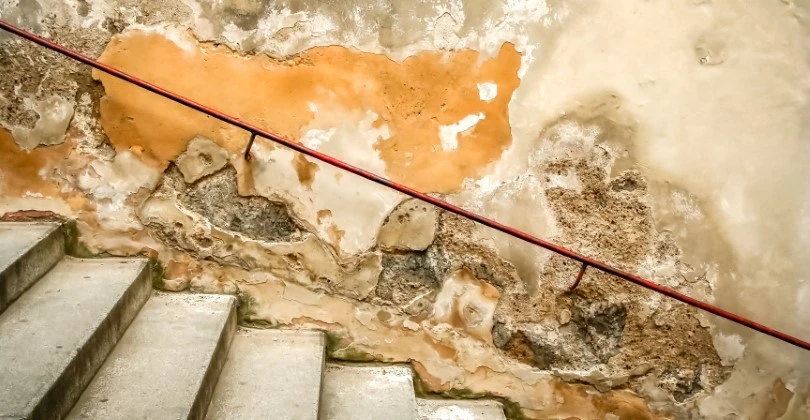Humidity - The 6 Most Important Dangerous Side Effects of Humidity
High humidity in the walls causes major problems in the house, and neglecting it causes unpleasant odors and mold that affect your health and the health of your family members, and can cause long-term structural damage to the building and be very expensive.
Article Content:
- Causes of wall humidity.
- Signs of wall humidity.
- The 6 dangerous effects of humidity on the building and the health of the residents.
- The role of BUILDING RANK in checking humidity.
- Treating wall humidity.
- When should you contact a plumber?
First: Causes of dampness in walls:
The presence of dampness in the walls is not only aesthetically disturbing, but can also lead to health problems and damage to the internal structure of the house, so it is necessary to look for its causes, which are:
- Water leakage: There may be water leakage from damaged pipes, sewage or even leakage from the roof. When water leaks into the walls, it accumulates and causes damage to the building materials, and causes mold and odors to grow.
- Lack of ventilation: The lack of adequate ventilation in the house leads to the accumulation of moisture in the walls. It causes the walls to gradually deteriorate.
- Moisture condensation: Condensation occurs when there is a difference in temperatures between the inside and outside. For example, when the cold wall and warm air collide with it, causing water condensation on the surface of the wall, leading to its gradual damage.
After knowing the real cause of these problems, treatment and maintenance are necessary.
Second: Signs of damp walls:
There are several signs that can be observed that show you that your walls are suffering from excessive moisture, including:
- Wet spots in the wall.
- Musty smell.
- Corrosion and rust of the metal elements in the place.
- Peeling paint.
- Wood rot.
If you notice one or more of the signs mentioned above, it is a sure sign of the presence of moisture at a high rate in your home.
Third: The 6 dangerous effects of moisture on the building and the health of residents:
This problem has many side effects, the most important of which are:
- Damage to building materials: When moisture accumulates in the walls, it can affect their components, such as cement, bricks and plaster. This can lead to a deterioration in the quality of the walls and their general weakness.
- Growth of mold and seaweed: Moisture is an ideal environment for the growth of mold and seaweed. It causes an unpleasant odor.
- Breathing problems: High humidity in the walls leads to the growth of mold, mites and bacteria. The presence of these microorganisms in the air inside the home will cause respiratory problems and allergies, such as asthma, sinusitis, and persistent cough.
- Skin and eye irritation: Mold and high humidity cause skin and eye irritation in some people. They may feel itchy and red skin, and inflamed eyes when exposed to this unhealthy environment.
- Increased allergies: High humidity acts as a catalyst for chemical reactions in building materials such as paints, furniture, and floors. This increases the sensitivity of some people, and causes symptoms such as headaches, dizziness, and nausea.
- Aggravation of asthma conditions: Mold, mites, and other pollutants associated with humidity can trigger asthma attacks, and make breathing difficult for people with asthma.
To reduce the health effects of this problem, it is important to take measures at home, by providing good ventilation, repairing water leaks, and periodically cleaning walls and surfaces exposed to moisture to prevent the growth of mold and bacteria.
Fourth: The role of BUILDING RANK in checking humidity:
To know the causes of this problem, we have the solution, so contact our company BUILDING RANK, which is the leading and first company in the Arab world in the field of home inspection, and our engineers have sufficient experience in detecting the causes of all problems in construction.
Our building inspection engineers use the best devices in the world without the need to break tiles or ceramics, and provide you with a report explaining the causes, and suggestions to solve this problem at the lowest costs and in record time.
Fifth: Treating wall humidity:
After examining and knowing the causes, the solutions come into play:
- Proper ventilation of the place, and using a humid air extraction device in the winter, thus reducing the risk of mold.
- Dealing with condensation by installing high-quality ventilation systems in the kitchen, bathroom, and laundry room. They work to extract humid air to the outside, thus preventing steam from condensing on the walls and furniture.
- Dealing with water leaks: Water leaks are often caused by plumbing errors, or cracks in the foundation, walls or gutters. If the cause of the water leak is one of the aforementioned reasons, you must treat them first.
Then, ventilate the place well to help dry the walls and thus solve this problem.
Sixth: When should you contact a plumber?
After identifying the causes of moisture in the walls and trying to treat them but to no avail, we advise you to seek the help of technicians specialized in this subject, as they have sufficient tools and experience, and have the ability to repair faults.
Conclusion: To reduce the effects of moisture in the walls, it is important to take measures to control its level in the home. By providing good ventilation, repairing water leaks, and periodically cleaning walls and surfaces exposed to moisture to prevent mold growth.



 العربية
العربية English
English 